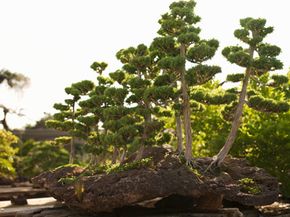Starting Your Own Bonsai Tree
Although a bonsai tree can be grown from a seed, started from a cutting or harvested in the wild (in areas where you can get permission to do so), the most common way to obtain a new plant for bonsai is through a reliable nursery. Start looking for a tree or shrub for bonsai in early spring. Choose a specimen that is 6 to 8 inches tall (15 to 20 cm) and has a strong, tapered trunk that is free of scars and blemishes [source: Lesniewicz]. The style you have in mind for your new bonsai tree, like upright, slanted, cascade or another traditional form, will help you select a plant variety with a good basic shape and the characteristics you need. Pruning and wiring bonsai is usually started in the second year and onward, but selecting a good basic shape will save you time and extra work later.
Choose a pot that will complement the color of the foliage and balance the tree's emerging design. Bonsai pots are typically shallow and always include drainage holes. The pot and tree work together to create the bonsai design, and although a bonsai tree may be planted in many pots during its life, each pot helps create balance and harmony in the overall design.
Advertisement
After choosing a specimen, potting the young tree is the first step in transforming it into bonsai. The following steps will help you turn a tree, shrub or other plant into a bonsai-in-training. The process of growing a true bonsai will take years, but these first steps are important because they will help your tree adjust to a shallow pot and a smaller root system.
- Make sure the young plant is well-watered before potting.
- Prepare the pot by feeding a length of small gauge bonsai wire through the drainage hole to support the tree until it becomes established.
- Place a thin layer of gravel in the bottom of the pot for drainage, temporarily blocking the drainage hole if too much gravel escapes.
- Remove the bonsai tree from its old pot, and remove the soil from around the roots. A bonsai root hook and rake can help make this part of the process easier.
- Inspect the roots, discarding any dead or damaged bits.
- Trim the roots by about two thirds. This seems extreme, but controlling root growth is an essential element in creating and maintaining bonsai. Given time and care, the tree will adjust to its new circumstances.
To continue with water, soil and sun for your bonsai, head over to the next page.
